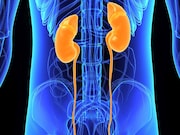However, medical-alert accessory not associated with difference in safety events versus usual care
THURSDAY, June 6, 2019 (HealthDay News) — A medical-alert accessory is associated with a lower rate of end-stage kidney disease (ESKD) among patients with chronic kidney disease (CKD), according to a study published online June 6 in the Clinical Journal of the American Society of Nephrology.
Eli Farhy, from the University of Maryland School of Medicine in Baltimore, and colleagues recruited 350 patients with stage 2 to 5 predialysis CKD. One hundred eight patients were given a medical-alert accessory indicating CKD diagnosis (pilot group); the remaining 242 patients received usual care (observation group).
The researchers observed no difference in the frequency of Class I and Class II safety events reported at annual visits in the pilot group versus the observation group (108.7 versus 100.6 events per 100 patient-visits [P = 0.13] and 38.3 versus 41.2 events per 100 patient-visits [P = 0.23], respectively). Compared with the observation group, the medical-alert accessory group had significantly lower crude and adjusted rates of ESKD (hazard ratios, 0.42 and 0.38, respectively). Over time, there was a variable association of the medical-alert accessory with the composite end point of ESKD or 50 percent reduction in glomerular filtration rate, but there was an early benefit with its use up to 23 months.
“The findings of this study demonstrate a potential benefit associated with use of a largely overlooked, relatively ubiquitous, and simple health information technology,” the authors write.
Copyright © 2019 HealthDay. All rights reserved.








